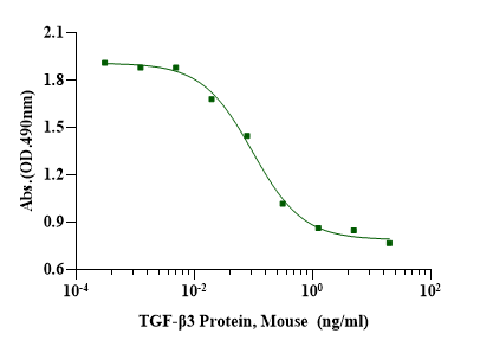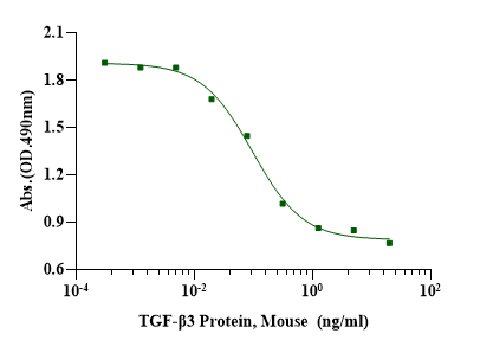Measured by its ability to inhibit the IL-4-dependent proliferation of HT‑2 mouse T cells. The EC50 for this effect is less than 0.2 ng/ml.
Product Details
Product Details
Product Specification
| Species | Mouse |
| Synonyms | Transforming growth factor beta-3; TGF-beta-3; TGF-β3; |
| Accession | P17125 |
| Amino Acid Sequence | Ala299-Ser410 |
| Expression System | HEK293 |
| Molecular Weight | 11-12 kDa (Reducing) |
| Purity | >95% by SDS-PAGE and HPLC. |
| Endotoxin | <0.1EU/μg |
| Conjugation | Unconjugated |
| Tag | No Tag |
| Physical Appearance | Lyophilized powder |
| Storage Buffer | 4mM HCl |
| Reconstitution | Reconstitute at 0.1-1 mg/ml according to the size in 4mM HCl after rapid centrifugation. |
| Stability & Storage | ·12 months from date of receipt, lyophilized powder stored at -20 to -80℃. |
| Reference | Bone Res. 2023 Jan 2;11:2. |
Background
TGF-beta 3 (transforming growth factor-beta 3) is a member of a TGF-beta superfamily subgroup that is defined by their structural and functional similarities. TGF-beta 3 and its closely related proteins, TGF-beta 1 and -beta 2, act as cellular switches to regulate immune function, cell proliferation, and epithelial-mesenchymal transition. The non-redundant biological effects of TGF-beta 3 include involvement in palatogenesis, chondrogenesis, and pulmonary development. Human TGF-beta 3 cDNA encodes a 412 amino acid (aa) precursor that contains a 20 aa signal peptide and a 392 aa proprotein. The proprotein is processed by a furin-like convertase to generate a 220 aa latency-associated peptide (LAP) and a 112 aa mature TGF-beta 3. Mature human TGF-beta 3 shows 100%, 99%, and 98% aa identity with mouse/dog/horse, rat, and pig TGF-beta 3, respectively. TGF-beta 3 is secreted as a complex with LAP. This latent form of TGF-beta 3 becomes active upon cleavage by plasmin, matrix metalloproteases, thrombospondin-1, and a subset of integrins. TGF-beta 3 binds with high affinity to TGF-beta RII, a type II serine/threonine kinase receptor. This receptor then phosphorylates and activates type I serine/threonine kinase receptors, TGF-beta RI or ALK-1, to modulate transcription through Smad phosphorylation. The divergent biological effects exerted by individual TGF-beta isoforms is dependent upon the recruitment of co-receptors (TGF-beta RIII and endoglin) and the subsequent initiation of Smad-dependent or -independent signaling pathways.
Picture
Picture
Bioactivity

SDS-PAGE
2μg (R: reducing condition, N: non-reducing condition).
RP-HPLC
>95% as determined by RP-HPLC.
ELISA
Immobilized TGF-β3 Protein, Mouse (Cat. No. UA040463) at 2.0μg/mL (100μL/well) can bind TGFBR2 Fc Chimera Protein, Mouse (Cat. No. UA010646) with EC50 of 11.16-14.01ng/mL.


